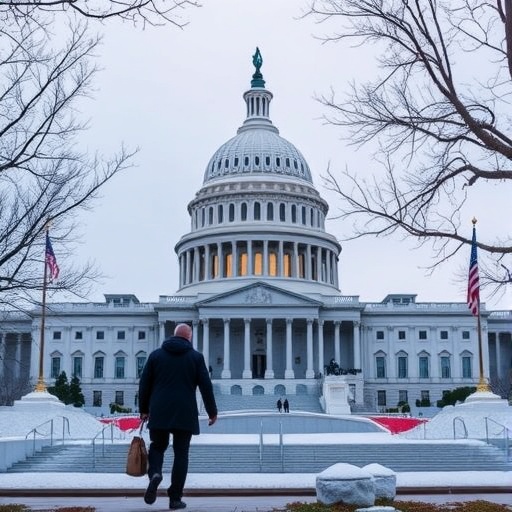US Government shutdown Ignites Fears of Trump Eroding Congress’s Spending Power Amid Frozen Federal Funding
In a stunning escalation of political brinkmanship, the United States plunged into a Government shutdown late Friday night, freezing billions in federal funding and casting a long shadow over Congress’s constitutional spending power. President Donald Trump’s insistence on securing border wall funding has led to this impasse, prompting widespread alarms that the executive branch is overstepping its bounds and undermining the legislative authority enshrined in the Constitution. As non-essential government operations grind to a halt, lawmakers from both parties scramble to avert deeper economic fallout, with the stakes higher than ever for America’s fiscal future.
- Border Wall Demands Trigger Partial Shutdown Chaos
- Frozen Federal Funding Exposes Vulnerabilities in Key Sectors
- Congress’s Spending Power Under Siege: Constitutional Experts Sound the Alarm
- Lawmakers Divided: Bipartisan Talks Stall Amid Partisan Finger-Pointing
- Path Forward: Economic Repercussions and Bipartisan Pathways to Resolution
Border Wall Demands Trigger Partial Shutdown Chaos
The Government shutdown was triggered by a fundamental clash over President Trump’s signature border security agenda. As the clock ticked past midnight on December 21, 2018, negotiations in Congress collapsed when Trump refused to sign a bipartisan spending bill that omitted $5.7 billion for his proposed border wall along the U.S.-Mexico frontier. This marked the third such shutdown during Trump’s presidency and the longest in U.S. history, surpassing the 21-day impasse of 1995-1996 under President Bill Clinton.
White House officials, including Press Secretary Sarah Sanders, defended the move in a statement: “President Trump is committed to securing our borders and will not sign a bill that fails to address this national security crisis.” The decision left approximately 800,000 federal employees—ranging from national park rangers to IRS auditors—furloughed without pay, while essential workers like air traffic controllers and border agents continued duties amid uncertainty. Economic analysts from the Congressional Budget Office (CBO) estimate the shutdown could cost the U.S. economy up to $1.5 billion per week in lost productivity, with ripple effects hitting small businesses and tourism sectors hardest.
Behind the scenes, the impasse revealed deep divisions within the Republican Party. Senate Majority Leader Mitch McConnell initially backed a clean continuing resolution to keep the government funded through March 2019, but Trump’s public veto threat on Twitter forced a reversal. “This is not about party; it’s about principle,” McConnell said in a floor speech, though critics accused him of capitulating to the president’s whims. Democrats, led by House Speaker Nancy Pelosi, held firm, arguing that border security enhancements could be addressed separately without tying them to unrelated federal funding.
Frozen Federal Funding Exposes Vulnerabilities in Key Sectors
The federal funding freeze has cascaded into immediate disruptions across multiple sectors, amplifying concerns about the fragility of America’s government-dependent infrastructure. National parks like Yosemite and the Grand Canyon closed to visitors, resulting in an estimated $76 million loss in visitor spending during the first week alone, according to the National Park Service. Smithsonian museums in Washington, D.C., shuttered their doors, denying access to millions of artifacts and halting educational programs that reach over 30 million people annually.
In the realm of scientific research, the National Institutes of Health (NIH) suspended new patient enrollments in clinical trials, potentially delaying breakthroughs in cancer and Alzheimer’s treatments. “We’re talking about real lives on hold,” said Dr. Francis Collins, NIH Director, in an interview with NPR. The Department of Housing and Urban Development (HUD) paused processing for low-income housing vouchers, leaving thousands of families in limbo amid a national affordable housing crisis. Statistics from the U.S. Department of Agriculture reveal that rural development programs, vital for farm subsidies, have been stalled, exacerbating financial strains on the agricultural sector already battered by trade wars.
Financial markets reacted swiftly, with the Dow Jones Industrial Average dipping 1.2% in the days following the shutdown announcement. Credit rating agency Moody’s warned that prolonged uncertainty could pressure the U.S. sovereign debt rating, potentially increasing borrowing costs for the federal government by tens of billions over time. For everyday Americans, the impact is palpable: Treasury Department data shows that tax refunds could be delayed into the new year, affecting an estimated 10 million filers who rely on them for debt relief or holiday spending.
- Transportation Disruptions: TSA screenings at airports slowed due to unpaid staff, leading to longer lines and travel delays.
- Environmental Monitoring: The Environmental Protection Agency (EPA) halted routine air and water quality tests in several states.
- Veterans’ Services: While VA hospitals remained open, administrative backlogs grew, delaying benefits for over 9 million veterans.
These interruptions underscore how a government shutdown doesn’t just pause bureaucracy—it halts the flow of essential services that underpin daily life.
Congress’s Spending Power Under Siege: Constitutional Experts Sound the Alarm
At the heart of the crisis lies a profound constitutional debate over Congress’s spending power, with legal scholars arguing that President Trump’s tactics represent an unprecedented assault on the separation of powers. Article I, Section 9 of the U.S. Constitution grants Congress the exclusive “power of the purse,” mandating that no money shall be drawn from the Treasury without legislative appropriation. Trump’s strategy—threatening vetoes and shutdowns to extract policy concessions—has fueled accusations of executive overreach.
Constitutional law professor Erwin Chemerinsky of the University of California, Irvine, articulated the gravity in a Washington Post op-ed: “By holding federal funding hostage, the president is effectively dictating congressional priorities, inverting the constitutional order. This isn’t negotiation; it’s coercion.” Historical precedents abound, from the 1974 Impoundment Control Act, which curbed President Nixon’s attempts to withhold congressionally approved funds, to Supreme Court rulings affirming Congress’s primacy in fiscal matters.
Within Congress, reactions have been sharply partisan. House Minority Leader Kevin McCarthy (R-CA) defended Trump, stating, “The president is exercising his rightful veto power to ensure taxpayer dollars are spent wisely on border security.” Conversely, Senate Minority Leader Chuck Schumer (D-NY) lambasted the approach during a press conference: “This shutdown is a power grab that mocks the Constitution. Congress, not the White House, controls the purse strings.” Bipartisan voices, including former House Speaker Paul Ryan, have urged compromise, warning that repeated shutdowns erode public trust in institutions.
Polls reflect the mounting frustration: A Quinnipiac University survey conducted mid-shutdown found 53% of Americans blaming Trump for the impasse, with approval ratings for Congress dipping to historic lows of 18%. Legal challenges are already brewing; advocacy groups like the American Civil Liberties Union (ACLU) are preparing lawsuits claiming the shutdown violates federal employees’ due process rights under the Fifth Amendment.
Lawmakers Divided: Bipartisan Talks Stall Amid Partisan Finger-Pointing
As the government shutdown stretches into its second week, congressional leaders remain deadlocked, with partisan rhetoric overshadowing substantive dialogue. In the House, Democrats passed two spending bills early in the session—one funding the government through February 15 and another allocating $1.3 trillion in discretionary spending without wall funds—but these measures died in the Republican-controlled Senate. Trump, meanwhile, hosted a high-profile White House meeting with congressional leaders, including Pelosi and Schumer, but it devolved into accusations rather than agreements.
“We’re not going to give in to this tantrum,” Pelosi declared post-meeting, emphasizing Democrats’ control of the House post-midterm elections. On the Republican side, hardliners like Sen. Rand Paul (R-KY) echoed Trump’s demands, tweeting, “No wall, no deal—America’s safety comes first.” Moderates, such as Sen. Susan Collins (R-ME), have pushed for alternative funding mechanisms, including reallocating from the Pentagon’s budget, which totals $700 billion annually and has faced scrutiny for waste.
Behind closed doors, informal talks continue via intermediaries. Reports from Politico indicate that a small group of centrist senators is exploring a compromise bill that includes $1.6 billion for border technology upgrades, excluding the physical wall. However, Trump’s base remains a wildcard; a Fox News poll shows 72% of Republicans supporting the shutdown if it advances wall construction. Economists, including those from the Brookings Institution, project that if unresolved by January, the shutdown could shave 0.5% off GDP growth in the first quarter of 2019, with unemployment ticking up by 0.2 percentage points.
- Day 1-7: Furloughs begin; parks close.
- Week 2: Back pay debates emerge in Congress.
- Potential Week 3: Debt ceiling talks could intersect, risking default.
The division highlights a broader erosion of bipartisanship, with the shutdown serving as a microcosm of polarized governance in Washington.
Path Forward: Economic Repercussions and Bipartisan Pathways to Resolution
Looking ahead, the government shutdown threatens cascading long-term effects on federal funding and national priorities, but glimmers of resolution offer hope. The Treasury Department has warned that without action, the U.S. could breach its debt limit as early as February 2019, potentially triggering a catastrophic default that would dwarf the 2011 debt ceiling crisis. Federal Reserve Chair Jerome Powell, in congressional testimony, cautioned that prolonged uncertainty could dampen consumer confidence and investment, with household spending—70% of GDP—already showing signs of slowdown.
On the political front, pressure is mounting from unlikely quarters. Business lobbies like the U.S. Chamber of Commerce have lobbied lawmakers, estimating $3 billion in monthly losses for affected industries. Governors from both parties, including California’s Gavin Newsom and Texas’s Greg Abbott, have called for federal intervention to backfill state budgets strained by the freeze. Internationally, the shutdown has embarrassed U.S. diplomacy; a NATO summit planned for early 2019 faces logistical hurdles due to unpaid State Department staff.
Experts suggest several pathways out: A short-term funding bill to reopen the government while negotiations continue, or Trump’s invocation of emergency powers under the National Emergencies Act to redirect funds—a move Democrats vow to challenge in court. As House Democrats prepare articles of impeachment unrelated to the shutdown, the impasse could entwine with larger battles over Trump’s spending power and executive authority. Ultimately, resolution hinges on compromise, with analysts predicting a deal by mid-January to minimize damage before the State of the Union address. For now, the nation watches as Congress grapples with reclaiming its constitutional role in an era of executive dominance.
In this high-stakes drama, the true cost may be the precedent set: If shutdowns become normalized tools for policy leverage, the delicate balance of American democracy hangs in the balance.








